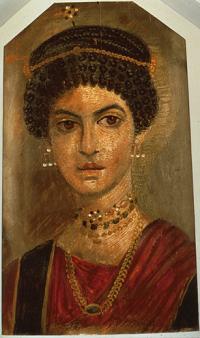This is an old revision of this page, as edited by Lanternix (talk | contribs) at 19:33, 28 May 2007 (moved Fayum mummy portraits to Faiyum mummy portraits: this is the correct English name for the city). The present address (URL) is a permanent link to this revision, which may differ significantly from the current revision.
Revision as of 19:33, 28 May 2007 by Lanternix (talk | contribs) (moved Fayum mummy portraits to Faiyum mummy portraits: this is the correct English name for the city)(diff) ← Previous revision | Latest revision (diff) | Newer revision → (diff)
Encaustic on wood; 43.7 x 34 cm (17 1/4 x 13 in.)
Royal Museum of Scotland, National Museums of Scotland, Edinburgh
Fayum mummy portraits is the name given to a large number of paintings from the first to third century. These are encaustic paintings, made with hot, pigmented wax on wooden, or in some cases cartonnage, panels, which were inserted into the mummies of the deceased. The surviving paintings are predominantly from the Fayum region in Roman Egypt, where the practice was common and the dry heat preserved many of the paintings until today.
The subjects of the paintings
Fayum became a cosmopolitan city during the Graeco-Roman period, where Egyptians and Greeks lived side by side. Some of its inhabitants were Greek soldiers who were settled by the Ptolemaic kings in reclaimed lands, but soon native Egyptians were brought from all over the country to settle and work, as attested by personal names, local cults and recovered papyri. The latter came from the Nile Delta, Upper Egypt, Oxyrhynchus and Memphis. It is estimated that as much as 30 percent of the population was Greek, with the rest being native Egyptians. By the Roman period, much of the "Greek" population of Fayum was made-up of either Hellenized Egyptians or people of mixed Egyptian-Greek origins. The Roman-period mummies found at Fayum were also compared with Egyptian populations since the predynastic period, and were found to be "most similar" and "much more closely akin to the seven dynastic samples."
Most of the portraits depict the deceased at a relatively young age, and many show children. According to Walker (2000), "CAT scans of all the complete mummies represented reveal a correspondence of age and, in suitable cases, sex between mummy and image." Walker concludes that the age distribution reflects the low life expectancy at the time. The wax portraits were completed during the life of the individual and displayed in their home, a custom that belonged to the traditions of Greek art. After the person was deceased, the portrait panel was placed over the mummified individuals face, an Egyptian tradition.
Together with the surviving frescoes and objects from Pompeii and Herculaneum, and tomb frescoes in Macedonia, they are the best preserved paintings from ancient times and are renowned for their remarkable naturalism. It is, however, debatable whether the portraits depict the subjects as they really were. Analyses have shown that the painters depicted faces in a repetitive and formulaic way, albeit with a variety of hairstyles and beards. They appear to have worked from a number of standard types without making detailed observations of the unique facial proportions of specific individuals which give each face its own personality.
Many museums around the world have fine examples of Fayum mummy portraits on display, notably the British Museum, the Royal Museum of Scotland, the Metropolitan Museum of Art in New York and the Louvre in Paris.
Gallery of images
-
 Fayum mummy portrait of a girl, early third century A.D.
Fayum mummy portrait of a girl, early third century A.D.
-
 Portrait of a Boy from the Fayum, on display at the National Museum in Warsaw.
Portrait of a Boy from the Fayum, on display at the National Museum in Warsaw.
-
Portrait of a young girl, on display at the Museo Egizio.
-
 Portrait of a man holding a plant, on display at the Musée des Beaux-Arts de Dijon.
Portrait of a man holding a plant, on display at the Musée des Beaux-Arts de Dijon.
-
Portrait of a young girl, on display at the Louvre.
-
Portrait of a young girl, on display at the Louvre.
-
 Portrait of a young boy, on display at the Metropolitan Museum of Art.
Portrait of a young boy, on display at the Metropolitan Museum of Art.
-
 Portrait of a man with black curly hair, on display at the Metropolitan Museum of Art.
Portrait of a man with black curly hair, on display at the Metropolitan Museum of Art.
Notes
- Portraits of the Ptolemies: Greek Kings as Egyptian Pharaohs, Paul Edmund Stanwick, University of Texas Press, p.23
- Bagnall, R.S. Susan Walker, ed. Ancient Faces : Mummy Portraits in Roman Egypt (Metropolitan Museum of Art Publications). New York: Routledge, 2000, p. 27
- Walker, op cit.
- Walker, op cit.
- Walker, pp. 28-29
- Irish JD (2006). "Who were the ancient Egyptians? Dental affinities among Neolithic through postdynastic peoples.". Am J Phys Anthropol 129 (4): 529-43
- Encyclopedia Of Ancient Greece, Nigel Guy, Routledge Taylor and Francis group, p.601
See also
References
- Walker, Susan (Ed.): Ancient Faces. Mummy Portraits from Roman Egypt. New York, 2000. ISBN 0-415-92744-7.
External links
- Proportion and personality in the Fayum Portraits, A.J.N.W Prag, November 2002